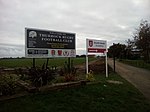Orsett Hall
Buildings and structures in ThurrockGrade II listed buildings in EssexHotels in Essex

Orsett Hall was a 17th-century Grade II listed building in Orsett, Essex (de-listed on 10 March 2008). It was set in 12 acres (4.9 ha) of parkland and was the centre of the Orsett Hall agricultural estate. The house was destroyed by fire on 11 May 2007 and rebuilt in the same style and on the same footprint as the original building in 2009.
Excerpt from the Wikipedia article Orsett Hall (License: CC BY-SA 3.0, Authors, Images).Orsett Hall
High Road, Thurrock
Geographical coordinates (GPS) Address Nearby Places Show on map
Geographical coordinates (GPS)
| Latitude | Longitude |
|---|---|
| N 51.51289 ° | E 0.36165 ° |
Address
High Road
High Road
RM16 3HB Thurrock
England, United Kingdom
Open on Google Maps









